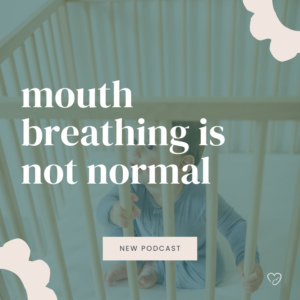We are now on the fourth and final post of this mini-series we’ve been doing all about oral restrictions! So far we’ve talked about:
- Our family’s journey with a tongue and lip tie (and high palate!) with our youngest
- A deep dive into all things oral restrictions with a lactation consultant
- What craniosacral therapy is and why it’s helpful specifically for oral restrictions
And now we will hear from Erica Cavaluzzi of Facial Fitness & Well-Being. She is an Oral Myofunctional therapist and will be explaining all things high palates and mouth breathing.
Introduce Yourself!
My name is Erica Cavaluzzi and I am the owner of Facial Fitness & Well-Being. I am an oral myofunctional therapist based out of Northern Virginia, but I serve patients virtually all over the country and the world! I work with children and adults of all ages, and our goal is to achieve optimal oral function and health.

What is Myofunctional Therapy and how did you get into it?
The technical definition is the repatterning of the tongue, the lips, the jaw, and facial muscle movements, through a series of specialized exercises. There’s nerve stimulation, there’s modification techniques, and it’s all geared toward restoring the symmetry of our face, the tone, and overall proper function.
Simply put, oral myofunctional therapy is physical therapy of the head and neck area. Just like a PT helps a patient relearn how to properly use their now restructured knee after surgery, I come in and support any structural changes being made to restore proper function of how facial muscles should be.
I was trained as a dental hygienist and had 20 years of caring for patients of all ages and watching them grow and change. I started to notice how many people had orthodontic relapse (i.e. they had braces but their teeth were crooked again) or were suddenly developing sleep issues, having more anxiety, taking more medication, etc.
My husband was also diagnosed with sleep apnea and started using a CPAP, but he didn’t “fit the bill” of what I thought apnea would look like. Similarly, I started to see issues with my children in regard to oral dysfunction, open mouth posture, and high palates.
As a dental hygienist and health care provider, as well as a wife and mom, I wondered what root cause I could be missing and what role I could play in helping. I started doing more research and stumbled upon oral myofunctional therapy!
I first started learning for myself, my family, and my patients, but now it’s grown into a whole practice.
Can you talk more about the palate? How should our tongue and palate work together, and why is a high palate such an issue?
It’s important to know that the roof of our mouth, or the palate, is the same bone as the floor of our nose. So if someone has a narrow palate, we know that the nose and openings of the nose are also narrow, and those nose openings are directly connected to our airflow! When we have a smaller nasal vault and therefore can’t get good airflow through our nose, we naturally mouth breathe more.
The main job of the tongue is to form and grow the palate (as well as other facial muscles), so if the tongue can’t reach up and rest against the roof of the mouth, it can’t help guide that forward growth and wide arch shape we’re looking for.
Did you know the palate actually forms in utero, around 6-12 weeks?
So for a baby with a tongue tie, for example, their tongue is tethered down and can’t elevate to that palate, therefore not helping the palate grow as it should. If a baby is born with a vaulted palate, that tells us right away that for some reason the tongue wasn’t providing the force the palate needed to form properly.
And that only impacts the development of their face as they keep getting older, not to mention that a high palate often leads to mouth breathing.
Why is mouth breathing a problem?
Our body is always looking to make the least effort. So when we have any kind of structural resistance through the nose, our body will do what it needs to survive. If mouth breathing is easier, the mouth breathing habit will begin.
However, we don’t just want to survive, we want to thrive. So we don’t want to allow mouth breathing to continue over time! That’s why it’s important to look for the root cause of mouth breathing and help facilitate nasal breathing.
Mouth breathing alone changes the way our face grows; it creates more of a long and narrow shape to the face, because the palate is more narrow.

With mouth breathing often comes more challenges, as there is no filtration system in the mouth like there is in the nose. This allows more bacteria into our bodies, which can lead to more health issues, including respiratory issues, lower PH, more cavities, gum disease, anxiety, ADHD, and more.
That mouth-breathing habit stimulates the sympathetic nervous system, which is our stress response. So when someone mouth breathes day and night, there’s no time for the parasympathetic nervous system to take over and allow rest and digest to kick in.
How do we stop mouth breathing?
The first thing I encourage people to do is to make sure their child (or themselves!) can blow their nose. We want to clear their nasal passages to help us understand if there’s a structural reason the body is using the mouth to breathe or if there’s an inflammatory reason.
Including nasal cleansing as a regular part of your daily routine helps reduce inflammation of the nasal passages and allows air to flow.
Then we look at the tongue and check for any tongue ties. When you take your tongue and press it up against the roof of their mouth, you cannot physically mouth breathe – your tongue becomes a seal and forces you to breathe through your nose. If, however, a person can’t bring their tongue to the roof of their mouth (tongue tie!), they are automatically set up for mouth breathing.
One tool that can help with oral posture is the Myo Munchee. It is a tool that teaches the mouth to sit in a closed position and facilitates proper chewing. The force of chewing is important in helping the jaw to grow well. Eating whole foods and a variety of textures early on also helps facilitate the jaw growth we’re looking for.
It’s important that you work with an educated airway provider. That might be a myofunctional therapist, an ENT, or a pediatric dentist, but it’s important that they are specifically trained in airway dysfunction issues.
Note, however, that none of these providers had airway education in school – anybody educated about airways has gone and done their own specialized training in function, tongue ties, and airway space. Something sparked our interest so we sought further education and training!
Then once you’ve connected with one of these providers, we can tell you what’s going on (is it structural or habit?) and what needs to be done moving forward.
What does an oral myofunctional therapy plan look like?
We are looking at exercises for the muscles of the face and techniques to retrain the tongue to do what it’s supposed to do. We have four main goals:
- Tongue rest posture
- How the lips work
- What the nose should be doing
- Chewing and swallowing
Just because an oral restriction is released or something is taken out doesn’t mean our body will now know how to function well.
If the reason for mouth breathing is a tongue tie, a baby, child, or adult might need to get that tongue tie revised and then retrain them how to properly use their tongue. We are trying to optimize the tone, coordination, and function of the tongue.
Similarly, if their adenoids or tonsils are too large and causing sleep issues, they may need to have those removed. If the body was breathing through the mouth due to that structural limitation, we will still mouth breathe out of habit, because again, it’s easy. So we retrain people how to use their nose, where the tongue should be placed to facilitate nasal breathing, and retrain the muscles to match the new structure that’s been achieved.
While an official myofunctional program can begin with children around the age of five, there are small practices you can start day one of a child’s life (i.e. closing their mouth when they sleep and nasal clearing!) to help line them up for proper form and function.
What is the role of orthodontics (namely palate expanders and braces) and why is myofunctional therapy still important?
Orthodontics is often focused on straightening teeth and creating a beautiful smile, and there is no harm in that.
Thinking more holistically, however, we want straight teeth AND a healthy airway space; the goal should be to look at form and function. We want the face to grow wide and allow the airway structure to develop in addition to teeth.
If we address one without the other, we don’t have long-term stability. Even for people who wear a retainer after orthodontic treatment, we sometimes still see re-crowding of the teeth or palates that have become narrow again, because the tongue and muscles never learned how to properly function. Or there could still be a physical restriction there.
That’s why the goal of oral myofunctional therapy is to retrain the muscles what to do.
Is there anything else you’d like to share?
I always encourage parents to trust their intuition. If you are noticing something that’s off with your child and you feel like you’re being dismissed from providers – maybe they’re telling you to “just wait” – know that there are providers out there who understand and have seen and connected all of these symptoms and who want change for everybody, too.
So just because your providers don’t understand or don’t know how to help, keep looking for someone who can help!
The epidemic of sleep-disordered breathing is deeply connected to how the mouth forms. And the earlier we can intervene, the more success we can have in changing people’s lives forever!
As a virtual oral myofunctional therapist, how can people work with you?
My business is called Facial Fitness & Well-Being, and you can learn a lot from my website, including further research about proper oral function.
I also offer a free consultation to bounce off ideas and share your concerns. This “meet and greet call” will help give you a feeling of what myofunctional therapy is and how we can work together.
I am a very open person and easy to talk to, and I love answering questions. I truly want to help your family, because there was a time when I had no one to turn to, and I don’t want that to be anyone else’s experience.
Let’s figure this out together! I’ll help you determine the best next steps, even if it’s not myofunctional therapy. If I’m not the right provider for you, I also have connections across the country and even in Europe, to help you find like-minded professionals with similar goals.
Conclusion
The main goal of this interview is to give you more knowledge; a knowledge and understanding of what’s common but not normal, so you can catch the red flags and know what to do with them. There are people who can help you and point you in the right direction, and Erica Cavaluzzi is a great resource to get you started.
The goal is also a knowledge that orthodontics isn’t the only tool when it comes to palate expansion, and knowing that oral myofunctional therapy exists so that you can make the best plan for your little one (or even yourself!) so we can all be our healthiest selves.
Finally, remember that you are not expected to be an expert in all of these areas. You are the expert on your child and can lean on others to guide and direct your steps. There won’t always be a clear-cut path, but there is the right support out there, it’s just a matter of finding it.
And if you haven’t read (or listened to!) the other posts in our series, here they are:
- Signs of our Baby’s Tongue Tie, Lip Tie, and High Palate
- Oral Restrictions Explained by a Lactation Counselor
- How Craniosacral Therapy Helps with Oral Restrictions
About the Author

Erica Cavaluzzi is a registered dental hygienist with a Bachelor of Science degree from the Pennsylvania College of Technology. Caring for patients since 2005, she is focused on full body wellness with a strong awareness of the importance of prevention and early intervention. A journey for ultimate health for her hygiene patients as well as herself, her husband, and her daughters sparked a strong interest and better understanding of the importance of proper facial, oral, and airway development.
As a result, she pursued further education and training in oral myofunctional therapy. She originally trained with the Academy of Orofacial Myofunctional Therapy in 2018. To further advance her knowledge she then pursued a mentorship with Sarah Hornsby through MyoMentor, expanded her knowledge of functional breathing with Dr. Dan Hanson, and became a certified MyoMunchee provider with Dr. Mary Bourke.
She continues to excel in her knowledge within the field of airway health as a member of Airway Circle and an advocate of the Breathe Institute. In 2020, Erica started Facial Fitness and Well-being, a virtual oral myofunctional therapy practice based in Northern VA where she serves clients of all ages. Erica is committed and truly enjoys coaching individuals through their health journey.